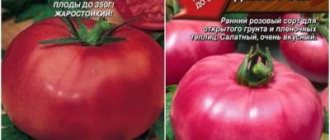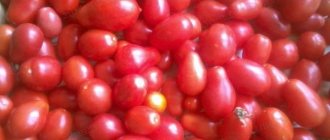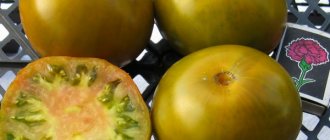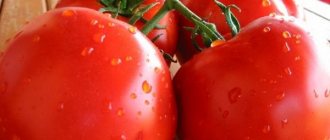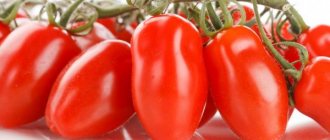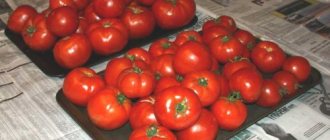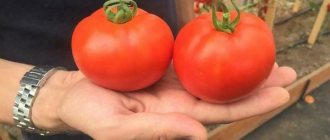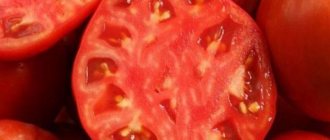Description of the variety
It is better to determine the place for planting, and a description of the variety will help to arrange the plants on the site. Taking into account all the necessary characteristics, the declared volume of harvest is obtained.
Plant:
- Early ripening. Tomatoes are consumed in a greenhouse on day 90, in open ground on day 110-120.
- Determinant.
- Height 50-55 cm.
- Compact.
- With a simple inflorescence.
Tomatoes:
- pepper-shaped;
- Red;
- high density;
- excellent taste;
- the skin is thick and peels off easily;
- weight 80-120 g;
- cameras 2-3 pcs.;
- can be stored for a long time;
- easy to transport.
Due to the high density of the pulp, tomatoes do not lose their shape even after the skin is removed.
Description of tomato Kaspar F1 with photo
The bush grows according to the determinant type: it reaches a height of 70 cm. If the variety is cultivated in a greenhouse, then the plant can grow up to 120 cm. The foliage is average. The leaf blades are of a rich green hue, complex in structure, dissected into 5-9 lobes. The flowers are bisexual, medium-sized, yellow in color, forming cysts of 4-6 pieces.
The first inflorescence of the plant is formed above the 8th leaf, the subsequent ones are formed through 1-2 leaf blades.
The root is in the form of a rod, and although it grows at an average speed, in an adult bush it is well developed, reaching a depth of 0.6 m. It can grow in width up to 0.7 m.
Important! And although the main stems are strong, the originators of the variety warn about the need for garter: under the weight of the fruit, the shoots bend to the ground and break off.
If you grow the Caspar tomato in the southern regions, you can avoid pinching: a favorable climate will allow you to get a good harvest. In countries with a changeable climate, formation will allow harvesting earlier, although in a slightly smaller volume.
The growing season is 100-110 days
Description of fruits
If you study the photo of the variety, the fruits of Caspar tomatoes can be characterized as a cylindrical vegetable. Tomatoes are similar in appearance to bell peppers. The weight of each tomato varies from 90 to 120 g.
Unripe vegetables are green in color, but as they ripen they become bright red in color. The skin of Caspar tomatoes is very dense. The variety has few chambers: no more than 2 or 3 nests are found in each fruit. The remaining contents of the tomato are juicy pulp with a pronounced tomato aroma. The dry matter content reaches 5.2%.
Caspar tomatoes can be described as very tasty and sweet tomatoes, with a small amount of acid: according to the tasting assessment, the variety received 4.6 points out of 5
Growing
Even beginners will not have any difficulties with landing. The peculiarity of the hybrid is that it must be tied up. Since there are a lot of fruits and the bush bends to the ground under their weight.
Cultivation is carried out using seedlings. This way the crop begins to ripen 2-3 weeks earlier. Seeds are sown 2 months before the expected date of transfer to the ground. Each summer resident calculates the period based on the characteristics of the growing region.
Pre-sowing treatment is not necessary, since Kaspar is a hybrid. Plants need to be looked after. Strong seedlings are the key to a future harvest.
A certain temperature regime is established in the room. The first 5 days +15-17 ⁰С, subsequent days +20-22 ⁰С. Plants need lighting for at least 14-16 hours so that the stems are straight and do not stretch.
Water as needed; do not overwater or overdry the soil. When the plants have formed 2 true leaves, the seedlings are planted in separate pots. As a result, a powerful root system is formed. Tomatoes are fed with growth stimulants.
Before planting, tomatoes are hardened 10-14 days before they are acclimated to growing conditions. To do this, take it outside for 10 days starting from 10-15 minutes. and ending at 8-10 hours.
8 plants per 1 m2 are planted in open ground.
Advantages and disadvantages
The advantages of the crop make it attractive to many amateur gardeners and farms.
- This tomato is very unpretentious to growing conditions and undemanding in care. Suitable for cultivation throughout almost the entire territory of Russia, with the exception of the extreme northern regions. And the variety is also suitable for industrial cultivation.
- High yields make the variety very attractive to farmers.
- The plant can develop normally and produce a good harvest without pinching.
- The culture is resistant to verticillium and fusarium.
- The fruits are not prone to cracking.
- The bushes of this type of tomato are quite compact. For 1 sq. m can fit 8-9 plants without compromising their growth and development. This feature will be useful for owners of small garden plots. Compact planting of bushes (a 30x70 cm pattern is sufficient for the plant) will significantly save space for other crops.
- Relatively long fruiting period.
- Unripe fruits removed from the bush have the ability to subsequently ripen without losing their properties and taste.
- The crop is universal in use. It is suitable for fresh consumption and for canning fruits in various ways. The thickened skin makes this type of tomato suitable for harvesting whole fruits.
- Thanks to their dense pulp, tomatoes do not produce excess juice when cut into a salad.
- Tomatoes of this variety tolerate transportation well and have a fairly long fresh shelf life. They are able to maintain an attractive presentation for a long time.
Read also: Garden care in September and October
In addition to the positive properties, it is still possible to highlight some disadvantages of this type of tomato.
- Too thick skin makes the fruits rough and tough when eaten fresh. It is advisable to remove it before cutting tomatoes into salad.
- Despite good immunity to many diseases, “Caspar F1” has very weak resistance to diseases such as blossom end rot.
- When grown in regions with a hot climate and cultivated in a greenhouse, the bushes almost always reach a height of more than a meter. Therefore, they require obligatory tying to arches or other support.
Features of care
Care is carried out as usual, watering in a timely manner, removing weeds and feeding the bushes.
See also
Description of the Etoile tomato and general characteristics of the variety
Read
This variety of tomato is popular with those summer residents who have limited growing area. They produce a rich harvest, and take up very little space.
All plants have a positive attitude towards loosening the soil, Kaspar is no exception. This provides oxygen access to the root system.
Weeding is especially necessary at the initial stage, when the plant needs nutrients for proper growth and development. And the weeds take most of it for themselves.
Pinching bushes as desired. It is recommended to grow the plant in 2 stems.
Water tomatoes with warm water in the evening or early in the morning, avoiding watering in the middle of the day.
Tasty and Healthy (ViP)
(From yellow Campari) (Campari - Italian)
Refreshing and aromatic…
An unusual, beautiful drink - the natural sweetness of Campari tomatoes gives energy, joy and pleasure!
Campari tomatoes (very juicy!), contain vitamins A, B6, C, as well as potassium, folate, iron, and are rich in fiber. So should you choose yellow or red Campari tomatoes, which is better? - Both contain vitamins and nutrients in almost equal quantities. But if the body needs more lycopene, red tomatoes are better, and if there is not enough iron, then yellow ones. No matter the shape or color, all tomatoes are healthy!
Campari, as is commonly believed, is a red cocktail tomato. But time does not stand still - now you can often see Campari tomatoes - and bright yellow ones. It seems that yellow tomatoes are more tender, and their skin is thinner - yes, this is true, and yellow Campari is also more aromatic. These beautiful round tomatoes are great in salads, and cocktails and drinks made from yellow Campari are high class! Tasty!
(Cocktail yellow Campari tomatoes). 100 g of Campari tomatoes are 25 calories!
Serves 2.
Ingredients.
8 Campari tomatoes, yellow 2 teaspoons honey, liquid 4 (2+2) glasses of cold water, filtered (or bottled) 12 blueberries (blueberries or 8 raspberries) 4 pieces of ice (optional) - (Evening drink option: - add 60g white vodka)
The oval-shaped ice is beautiful, like candy canes. And the ice tray has a lid, like a box. Pieces of ice quickly and easily come out of the mold - you just need to touch the soft “bottom” of the tray with your fingers, and voila! - the ice is already “free”. (Interesting design - such ice molds are produced by the French company Mastrad). Beautiful - and convenient.
Preparation.
— Prepare ice in advance, preferably 2 molds (ice will be needed to pre-cool the glasses).
— Prepare 2 tall glasses. Fill them halfway or more with ice cubes to keep the glasses cool. Set them aside for now.
— Cocktail tomatoes and berries, wash. Set the berries aside for now.
— Set aside 2 Campari for decoration, or rather, for effect.
Then cut these 2 Campari tomatoes with a knife on top (where the green leg was) - 1 cm deep. After this, it will be easier to pierce the tomato with a skewer.
Put it aside for now.
— Choose 2 Campari tomatoes (the softest). Mash them slightly in a mug (you can use a fork or in a blender, whichever is more convenient), squeeze the juice out of them.
— Pass the resulting tomato juice and Campari tomato pulp through a strainer (discard the peel and seeds).
Preparation.
— Remove the ice from the prepared glasses (throw away the ice).
1. Place tomato juice and pulp of yellow Campari tomatoes at the bottom of glasses (you can fill 2 glasses at the same time), dividing the mixture in half. 2. Throw 2 pieces of ice into glasses (optional). 3. Then place 2 yellow tomatoes. 4. Sprinkle in blueberries. 5. Pour in 1 teaspoon of honey. (If it’s an “evening version” of the drink, add vodka after the honey). 6. Fill the glasses with cold water, but not to the very top. 7. Pierce the Campari tomatoes left for decoration and place on skewers.
Then place the skewers with tomatoes into the glasses (Add a little water if necessary).
Insert straws into glasses containing drinks. Ready!
And serve immediately.
...Golden-yellow Campari tomatoes, round like balls, are beautiful and bright. The taste of the tomato drink is very pleasant, fresh - it can be prepared both in summer and winter (Campari tomatoes can be bought all year round). Ball tomatoes look like miniature soccer balls. And the past 2015, for football fans, and especially the Dynamo (Kyiv) football team, was an anniversary year.
Back in 1975, the Kiev team became the winner in the final matches of the prestigious Cup Winners' Cup and UEFA Super Cup, and won the USSR championship. And Dynamo (Kyiv) footballer Oleg Blokhin received the Golden Ball prize (France Football's Ballon d'Or) and was awarded the title of "Best Footballer in Europe". It was unheard of success, honor, love, glory... The people of Kiev were in a state of heady euphoria and great pride “for our Dynamo.” Even the word “Kievite” sounded proud, and the residents of the capital of Ukraine adored Oleg Blokhin, their football idol, and literally carried him in their arms...
Then, the title of “Best Footballer in Europe” was awarded to Dynamo Kiev player Igor Belanov in 1986. And already in the 21st century, another Dynamo football player, Andrei Shevchenko, received the Golden Ball prize in 2004, playing for the Italian Milan.
Three such football celebrities in Dynamo (Kyiv)! So, this is a solid anniversary! You can celebrate all year long. There is something to remember - successes, defeats, famous matches of your favorite team, victories, championships, Euro 2012, awards - there is something to talk about.
Interesting to know . The Ballon d'Or, an annual football award, was created in France by the editors of France Football magazine in 1956. The prize was awarded to the best football player of the year. It could be a player for whom coaches and captains of national football teams, and journalists from all over the world voted. Every year, the “Golden Ball” became an increasingly popular, prestigious award and went beyond the borders of Europe. Since 2010, the two awards, the Ballon d'Or and the FIFA Player of the Year, have been combined into one, now the FIFA Ballon d'Or. The first winner of the world FIFA Ballon d'Or was Argentinean Lionel Messi (Barcelona).
...And from the end of November, at the end of the calendar year, FIFA begins counting votes. And when the winner is determined, the award will be presented to him at the official ceremony, which will take place in early January in Zurich.
Who will win the FIFA Ballon d'Or in 2021? In the list of those nominated, that is, they received a nomination, there were 23 football players in the world. Maybe there will be Lionel Messi (again), maybe Cristiano Ronaldo, last year's prize winner, will be (again)? Or maybe someone else will become the best football player in the world, like, for example, Arturo Vidal, Alexis Sanchez, or the fearless Brazilian Neymar?... Soon (January 11, 2016) we will know about it, or rather, soon everyone will know about it world!.
These are the hot football passions! — It’s good to meet with friends, argue, and try a delicious, cool “Tomato Drink with Honey”, and wish your favorite football player to become the owner of the “Golden Ball”!
Bon appetit! Good luck and good spirits!
Besides:
- Salad with yellow and red Campari tomatoes…
- Salad with sardines and cherry tomatoes
- Persimmon and berry smoothie (Persimmon - English)
- Omelet with onions and green peppers
- Smoothie with kiwi and spinach
- Gooseberry and raspberry compote
- Blackcurrant compote
- Cosmopolitan cocktail (light version)
- Tangerine smoothie (with strawberries and banana)
Advantages and disadvantages
As the characteristics of the variety and numerous positive reviews from summer residents show, the variety has more positive properties than negative ones.
Pros:
- stable, high yield;
- simultaneous maturation;
- high density;
- versatility in use;
- tomatoes do not crack;
- excellent taste characteristics;
- immunity to certain diseases;
- undemanding and unpretentiousness;
- fruits last a long time and can be transported over long distances;
- the best variety for canning, salting and pickling.
Minuses:
- very rough skin;
- it is necessary to secure the brushes;
- seed material collected from Caspar f1 does not retain the parental genes.
The negative characteristics are insignificant compared to the number of advantages this hybrid has.
Pests and diseases
Breeders develop hybrids with high immunity. This criterion is one of the main ones for a summer resident when choosing any category of plants. After all, disease-resistant crops are easier to grow.
Caspar tomato, which resists the following diseases:
- fusarium wilt;
- verticillium wilt.
It is attacked by aphids. It suffers especially badly from late blight and blossom end rot.
Preventive treatment of plants will help save the bush from losing part of the harvest.
Harvest volume and household use
An important selection criterion is the number of fruits the plant produces. The higher the yield, the greater the likelihood of growing popularity of the hybrid. The Kaspar tomato variety yields 10-11 kg per 1 m2. Subject to all rules of cultivation and care.
See also
Description of the tomato variety Werner f1, its characteristics and cultivation
Read
Tomatoes can be used for any cooking method. Tomatoes are especially well used for winter preparations. Vegetables are suitable for preparing fillings and salads.
Landing
Caspar F1 tomato seeds are sown for seedlings from the end of February, the first half of March. Store-bought seed material does not require preliminary preparation, as it is treated with activators and disinfected. If the seeds are prepared independently, then potassium permanganate and a soda solution are used for disinfection.
To stimulate, soak the seeds for 10 hours in Agate, Zircon, homemade aloe vera recipe with water. From the container they use:
- boxes and containers;
- cups and pots (0.2 l);
- peat tablets.
To fill the containers, use a soil mixture of turf, peat, humus, and vermiculite. The soil is moistened, the seeds are planted to a depth of 1 cm. The top is sprinkled with fine soil. The seedlings are covered with film, glass, and a constant temperature of 25-27 degrees is provided. When shoots appear, the shelter is removed and the temperature is lowered to 22 degrees.
Nuances of caring for seedlings:
- irrigation through a spray bottle;
- 2 feedings (before picking and after);
- diving in the presence of 1-2 true leaves;
- hardening 10-12 days.
Seedlings are ready for planting when 8-9 leaves grow at the age of 56-58 days. The crop is planted in greenhouse conditions from the last ten days of April - the first half of May. Planting in uncovered beds begins at the end of May.
On the site there are 3-4 bushes per 1 m2.
